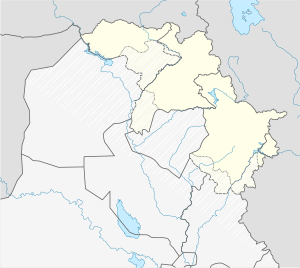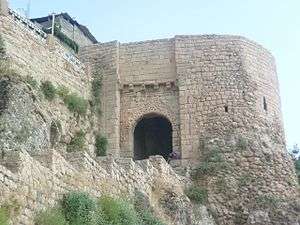Amadiya
Amadiya /ˌɑːməˈdiːə/ (Kurdish: Amêdî ,ئامێدی,[1][2] Arabic: العمادية) is an Kurdish town and popular summer resort and Hill station along a tributary to the Great Zab in the Dahuk Governorate of Kurdistan Region.[3] The city is situated 4,600 feet (1,400 m) above sea level.
Amadiya Amêdî, ئامێدی | |
|---|---|
 Amadiya bird's eye view | |
 Amadiya  Amadiya | |
| Coordinates: 37°05′33″N 43°29′14″E | |
| Country | |
| Autonomous region | |
| Governorate | Dohuk Governorate |
| District | Amadiya District |
| Founded | Before 3000 B.C. |
| Government | |
| • Type | Mayor |
| Elevation | 3,900 ft (1,200 m) |
| Population | |
| • Total | 11,000 |
| Time zone | GMT +3 |
| Postcode | 42008 |
History
The history of the city of Amadiya goes back as far as ancient Assyria and it has probably existed even prior to that due to its strategic place on the flat top of a mountain.[4] It was an Assyrian city known as Amedi from the 25th century BC until the end of the 7th century BC with the fall of the Neo-Assyrian Empire. After that, it was part of Achaemenid Assyria, Seleucid Assyria and Parthian and Sassanid-ruled Assyria until its conquest in the mid 7th century AD by the Arabs[5] Then, for several centuries, after the expulsion of the caliphs from Baghdad in the 7th century, it was ruled by a pasha from the royal Abbas family, reputed to be one of the richest families in the region.[6]
The region in which the city rests is believed to have been the seat of the Magi, or high priests of Median-ruled Assyria, and the city itself is believed to be the home of some of the most significant Magi priests: the Biblical Magi or the "Three Wise Men" who made a pilgrimage to Bethlehem to see Jesus Christ shortly after his birth.[7]
Amadiya was the birthplace of the pseudo-Messiah, David Alroy (fl. 1160). In 1163, according to Joseph ha-Kohen's "'Emeḳ ha-Baka", the Jewish population numbered about a thousand families and traded in gall-nuts. Alroy led a revolt against the city but was apparently defeated and killed in the process.[8] The Spanish Jewish historian R. Schlomo Ibn Verga (1450–1525) portrayed the Jewish community of Amadiya at the time of Alroy as wealthy and contented.[9]
Amadiya was the seat of the semi-autonomous Badinan Emirate, which lasted from 1376 to 1843. At the turn of the 19th century, the population already numbered 6,000, of whom 2,500 were Kurds, 1,900 Jews and 1,600 Assyrians. There are ruins from the Assyrian era and ruins of a synagogue and a tomb attributed to Ezekiel and a church in the small town.[10] The city also has mosques and a church.[11][12] One of the icons of the city is Great Mosque of Amadiya which dates back to the 12th century and the oldest and largest in the region.[13]
Geography
The town is perched on a mesa or a plateau, formerly only accessible by a narrow stairway cut into the rock. Amadiya has a well-integrated community of Assyrian Christians, Jews and Muslim Kurds who share the city and local social events.[11]
Although Amadiya is just 10 1⁄2 miles (16.9 km) from the Turkish border across the Beshesh Mountains, the only border crossing into Turkey is now at Ibrahim Khalil border on the road Amadiya - Dohuk - Zakho, 56 miles (90 km) away. A border crossing was once at Habur.
The region north of the mountainous region on the border with Turkey is where poplar, willow, oak, hawthorn, cherry plum, rose hips, mountain apple, pear, Sorbus, and other wild trees and meadow grasses are usually located. The town is 1,100 yards (1,000 m) long and 550 yards (500 m) wide. It houses 6,000 citizens in almost 1,200 houses.
Climate
Amadiya has a hot-summer Mediterranean climate (Köppen climate classification: Csa) with long, hot summers and cool, wet winters. Being the most northerly city in Iraq, it is the mildest major city in the country.
| Climate data for Amadiya | |||||||||||||
|---|---|---|---|---|---|---|---|---|---|---|---|---|---|
| Month | Jan | Feb | Mar | Apr | May | Jun | Jul | Aug | Sep | Oct | Nov | Dec | Year |
| Average high °C (°F) | 6.2 (43.2) |
7.8 (46.0) |
12.1 (53.8) |
17.8 (64.0) |
25.1 (77.2) |
31.9 (89.4) |
36.3 (97.3) |
36.2 (97.2) |
32.2 (90.0) |
24.4 (75.9) |
15.4 (59.7) |
8.4 (47.1) |
21.2 (70.2) |
| Daily mean °C (°F) | 1.9 (35.4) |
3.2 (37.8) |
7.2 (45.0) |
12.5 (54.5) |
18.8 (65.8) |
24.6 (76.3) |
28.8 (83.8) |
28.5 (83.3) |
24.5 (76.1) |
17.6 (63.7) |
10.2 (50.4) |
4.2 (39.6) |
15.2 (59.4) |
| Average low °C (°F) | −2.4 (27.7) |
−1.3 (29.7) |
2.4 (36.3) |
7.2 (45.0) |
12.5 (54.5) |
17.4 (63.3) |
21.4 (70.5) |
20.9 (69.6) |
16.8 (62.2) |
10.9 (51.6) |
5.0 (41.0) |
0.0 (32.0) |
9.2 (48.6) |
| Average precipitation mm (inches) | 126 (5.0) |
176 (6.9) |
156 (6.1) |
128 (5.0) |
56 (2.2) |
0 (0) |
0 (0) |
0 (0) |
1 (0.0) |
32 (1.3) |
96 (3.8) |
126 (5.0) |
897 (35.3) |
| Average precipitation days | 7 | 6 | 10 | 8 | 4 | 0 | 0 | 0 | 1 | 7 | 7 | 10 | 60 |
| Source 1: World Weather Online (precipitation days)[14] | |||||||||||||
| Source 2: Climate-Data (temperatures and rainfall amount)[15] | |||||||||||||
Gallery
 The capital of the district, Amadiya, Iraqi Kurdistan
The capital of the district, Amadiya, Iraqi Kurdistan Citadel of Al Amadiya
Citadel of Al Amadiya The Badinan Gate, and the entrance to the Citadel
The Badinan Gate, and the entrance to the Citadel



References
- "Li sînorê Gare 12 gund ji ber bombebaranên Tirkiyê hatine valakirin". Rûdaw (in Kurdish). Retrieved 18 December 2019.
- "ئامێدی | كوردستانی سەرسوڕهێنەر- وێبسایتی فەرمی دەستەی گشتی گەشت و گوزار". bot.gov.krd. Retrieved 18 December 2019.
- Naval Intelligence Division (1944). Iraq and the Persian Gulf. Geographical Handbook Series. OCLC 1077604.
- Karen Dabrowska; Geoff Hann (2008). Iraq Then and Now: A Guide to the Country and Its People. Bradt Travel Guides. pp. 177–. ISBN 978-1-84162-243-9.
- "Limmu List (858-699 BCE) - Livius". www.livius.org.
- Wright, George Newenham (1834). A New and Comprehensive gazetteer, Volume 1. T. Kelly. Retrieved 2009-09-12.
- Bailey, Betty Jane (2003). Who are the Christians in the Middle East?. Wm. B. Eerdmans.
- "Jewish Encyclopedia". 1906. Retrieved 2009-09-12.
- Lenowitz, Harris (1906). The Jewish Messiahs: From the Galilee to Crown Heights. Retrieved 2009-09-12.
- "Catholic Encyclopaedia". Appleton. 1907. Retrieved 2009-09-12.
- "Driving in Iraqi Kurdistan - Amedi to Barzan Road Trip". 13 June 2015.
When I was in the Kurdish town of Amediay.
- "Maryam Alazra church – Emmadeya". www.ishtartv.com.
- “ذو الكفل” يجمع المسلمين والمسيحيين واليهود في العمادية العراقية. Kitabat. Retrieved January 11, 2018.
- "Weather averages for Amadiya". World Weather Online. Retrieved September 6, 2014.
- "Weather averages for Amadiya". Climate-Data. Retrieved 21 January 2017.
External links
